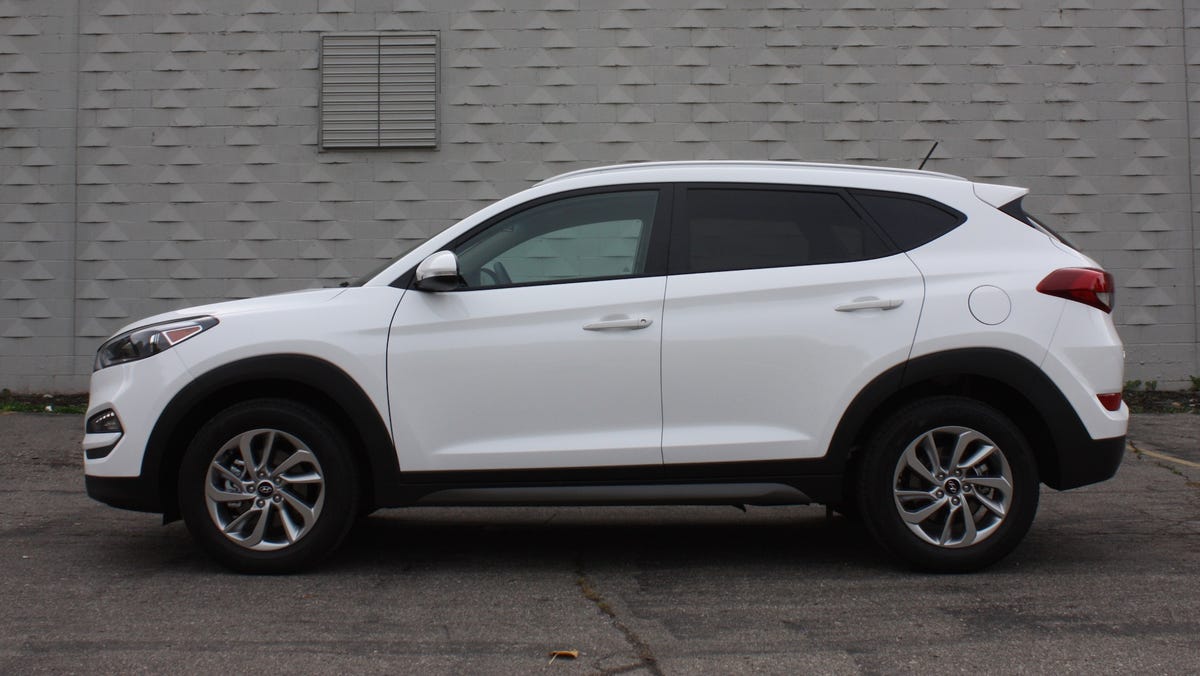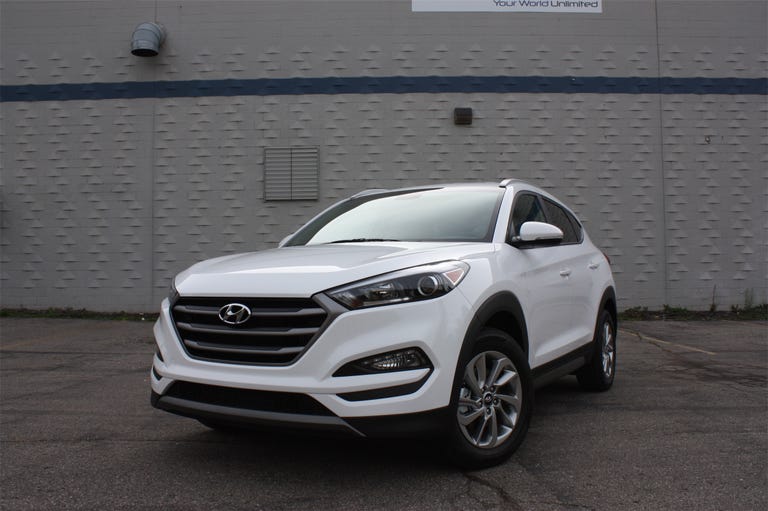 Why You Can Trust CNET
Why You Can Trust CNET 2016 Hyundai Tucson Eco review: Hyundai's new compact SUV is a solid choice, just not in this trim
In this case, "Eco" should be a four-letter word
Sometimes, it's easy to forget how significantly a single car can vary in character and competency depending on the trim level and options chosen. These days, most vehicles are so thoroughly designed and vetted that it's rare for a bum steer to find its way onto dealer lots.
The Good
The Bad
The Bottom Line
What we have here, however, is a rare exception to that rule.
Don't get me wrong -- the 2016 Hyundai Tucson is a perfectly nice compact SUV in most trims, but the Eco seen here is a model I'd avoid.

A tapered greenhouse lends the Tucson an athletic profile.
Like all other third-generation Tucsons, the Eco is quietly handsome, with good proportions, tautly drawn sheet metal, and few wasted lines. All new for 2016, Hyundai's entry-level crossover has grown in size, and now sits in between most subcompact models like the Honda HR-V and Mazda CX-3 and their next-size-up brethren, the CR-V and CX-5 , making it a little tough to find a fair set of competitors.
A high-tech, flawed powertrain
Regardless of its tweener size, it's the Tucson Eco's thoroughly modern powertrain that lets it down. Like the Sport and Limited models, the Eco receives a new 1.6-liter turbocharged, direct-injected four-cylinder from Hyundai's Gamma engine family, generating 175 horsepower and 195 pound-feet of torque. Those figures suggest it has the potential to be a pretty nice unit, especially as the torque peak arrives just off idle at 1,500rpm and sticks around until 4,500 revs, which is right in the wheelhouse of 95 percent of daily driving.
I say "potential," because while the 1.6 is quiet and has plenty of torque just off idle, the other part of the powertrain equation lets down the whole drive experience. The Eco is offered exclusively with Hyundai's new seven-speed EcoShift dual-clutch transmission, and while car writers typically get excited about DCTs because of their ability to pre-engage the next cog to deliver lightning-quick gear changes, the Hyundai unit disappoints in this application. Unfortunately, while the Tucson's shifts can arrive quickly depending on what drive mode the vehicle is set in, gear swaps often fail to arrive smoothly. You needn't be seeking high-performance motoring to find the burrs in this setup, as they show up in regular commuting, especially in around-town, low-speed trundling.
This 1.6-liter Gamma engine generates 175 hp and 195 pound-feet of torque.
In the case of my test car, the Eco's engine and transmission didn't always feel like they were reading from the same playbook -- there was an occasionally fumbling, discombobulated quality to their interactions. That was particularly the case when the three-position drive mode selector was placed in Eco, which is ostensibly this model's raison d'être in the first place. It's not that Eco mode -- which retards the throttle and alters the transmission's shift schedule -- is too slow. It's definitely not quick, but the dulled-acceleration quotient it brings about is certainly manageable. It's that it's entirely too easy to get the transmission caught out in city traffic, resulting in a thunk in the back or unexpectedly jerky progress, particularly in very low-speed work (0-10 miles an hour, and 10-0 mph, as when creeping forward in a left-turn lane queue or slowing to a stop sign). Shifts can be ill-timed in addition to being uncultivated, too, especially on low-speed inclines. Sorry, San Franciscans.
Normal and Sport modes are somewhat better, but there are still moments where it feels like this powertrain hasn't been completely vetted, as if the consumer is an unwitting beta tester. And since Hyundai hasn't bothered to fit the Tucson Eco with paddle shifters, drivers can't even take advantage of one of the best and most enjoyable qualities inherent in dual-clutch transmissions -- their ability to snap off a quick and satisfying manual gearchange. Automated downshifts often aren't quite quick enough, either. Oddly for an eco model, there's no stop/start system, which is a cornerstone of most green-minded models these days.
In exchange for putting up with its stilted performance, all-wheel-drive Tucson Eco models like my test car return 25 miles per gallon in the city and 31 on the highway according to EPA estimates. Eco models equipped with front-wheel drive fare better, netting 26 city and 33 highway. Those government estimates, for the record, are slightly inferior to that of the Honda CR-V, which is at once larger, heavier and quicker. I registered 24.3 mpg in mixed driving.
The Tucson Eco's interior is marred by cheap finishes and a lack of options.
A disappointing cabin
Nor is the Tucson Eco particularly posh inside. Tap on the door panels and the dashboard, and you'll find unyielding, hard plastics. Grab the wheel and your fingertips are met with urethane. Other Tucson trims offer thicker, soft-touch dash caps, leather-wrapped steering wheels, proximity keys with pushbutton start, and a lot more equipment. The Eco skimps, ostensibly to keep weight down in the interest of eking out better fuel economy.
Such material choices are perfectly appropriate in the entry-level SE model, but at $26,445 for an Eco model with no options save all-wheel drive ($1,400), it's disappointing. That's $130 less than a Honda CR-V SE AWD, but the latter includes more power and space, and it's a better drive. In recent years, Hyundai has built a hard-earned reputation for offering more standard equipment for less money than its rivals, but the Tucson is the first model I've driven from the Korean automaker in ages that fails to reflect that value positioning.
Of course, there are a lot of plusses inside, even in this Eco model. The Tucson's driving position is well chosen, with simple secondary controls and first-rate ergonomics. Unfortunately, only the top-flight Tucson Limited is available with Hyundai's Blue Link navigation system, but in previous encounters, this system has been one of the easiest-to-use mass-market infotainment setups, with clear menu structures and snappy performance. The Eco makes do with a serviceable-sounding six-speaker audio system that incorporates a five-inch touchscreen, SiriusXM, Bluetooth audio and telephony, along with a USB input. Apple CarPlay and Android Auto are not yet offered on any 2016 Tucson model.
With the rear seats folded, cargo space nearly doubles to 61.9 cubic feet.
The Tucson is also eminently practical, with plenty of space for odds and ends up front, and in back, the new generation's cargo hold is also substantially larger, sitting at a solid 31 cubic feet. There's even a dual-level cargo floor. The second-row seats are accommodating as well, and on long road trips, kids will appreciate having backrests that can recline to 37 degrees to facilitate easy napping. Incidentally, while leather surfaces are available on other Tucson models, the cloth seats are stitched in Yes! Essentials, a stain-, odor- and static-resistant fabric. The upholstery itself isn't the richest feeling, but it's a good tradeoff for a family-minded conveyance, and the seats themselves are appropriately supportive.
Unlike the engine and transmission combination, the rest of the Eco's driver inputs don't stand out for the wrong reasons. The brakes have a nicely progressive action, as does the speed-sensitive electric power steering. The latter doesn't offer much feedback as understeer sets in while engaged in hard cornering, but it builds weight off center progressively, and it's well-weighted (particularly in sport mode, which adds a bit of heft). It even rides quite well on its 17-inch tires.
17-inch alloy wheels are standard on Tucson SE and Eco trims.
Other Tucson trims are better
The Eco's biggest competition may end up being from within -- Hyundai's other Tucson models are fully baked in comparison.
The base SE may have the same discount cabin furnishings, but at $23,595 delivered, there's not much to complain about. It may use a less-powerful engine (164 hp and 151 pound-feet), but it's perfectly adequate, and it pairs more agreeably with its conventional six-speed automatic. (In the UK, the Tucson starts at £18,695 and comes with the 1.6L and a manual gearbox; Australian shoppers should expect to pay $27,990 plus on-the-road costs).
But here's the funny thing -- the upper-end Limited model ($30,795) that I sampled briefly exhibited virtually none of the Eco's undesirable behavior. That's strange, because it also uses the same 1.6-liter four and DCT as this Eco, albeit with a different calibration. The blame for the Eco's vastly different character apparently lies in the programming. (Mine wasn't a one-off problem -- I surveyed other car writers who have driven other Tucson Eco models, and they all shared my sentiments).
This is a perfectly nice CUV, just avoid those three dreaded letters on the back: "E-C-O."
To be fair, all those ones and zeros in the Eco (along with its lighter, flimsier interior bits) do improve its fuel economy over the Limited -- the Eco AWD nabs 25 mpg city and 31 highway, as mentioned previously. The posher Limited AWD earns EPA estimates of 24 city and 28 highway, but the combined cycle numbers are only a single, solitary mile per gallon apart -- 27 versus 26. I'd struggle to recommend the Eco over its Tucson brethren even if the efficiency gap was two or three times what it actually is, because the refinement gulf is genuinely aggravating.
The other Tucson models make better cases for themselves in terms of available equipment, too -- outside of choosing front- or all-wheel-drive motivation, the Eco is basically a mono-spec proposition with no options available. Not only are you missing out on "nice to haves" like ventilated power seats, navigation and a panoramic moonroof, you can't even get any of the advanced driver-assistance safety options like automatic emergency braking with pedestrian detection, lane-departure warning, or HID cornering headlamps offered in other trims.
The bottom line? If you're in the market for a compact SUV, definitely check out the Hyundai Tucson -- just be sure to skip the Eco model.


